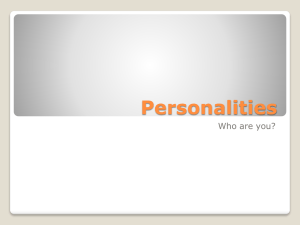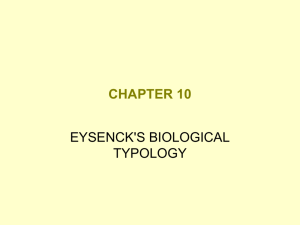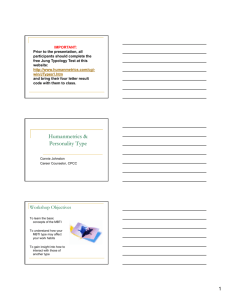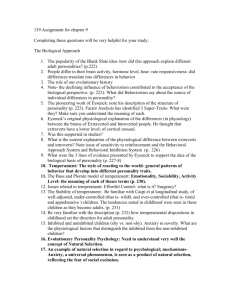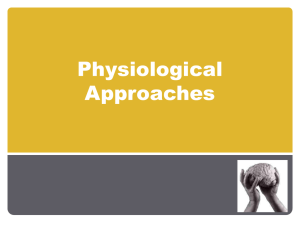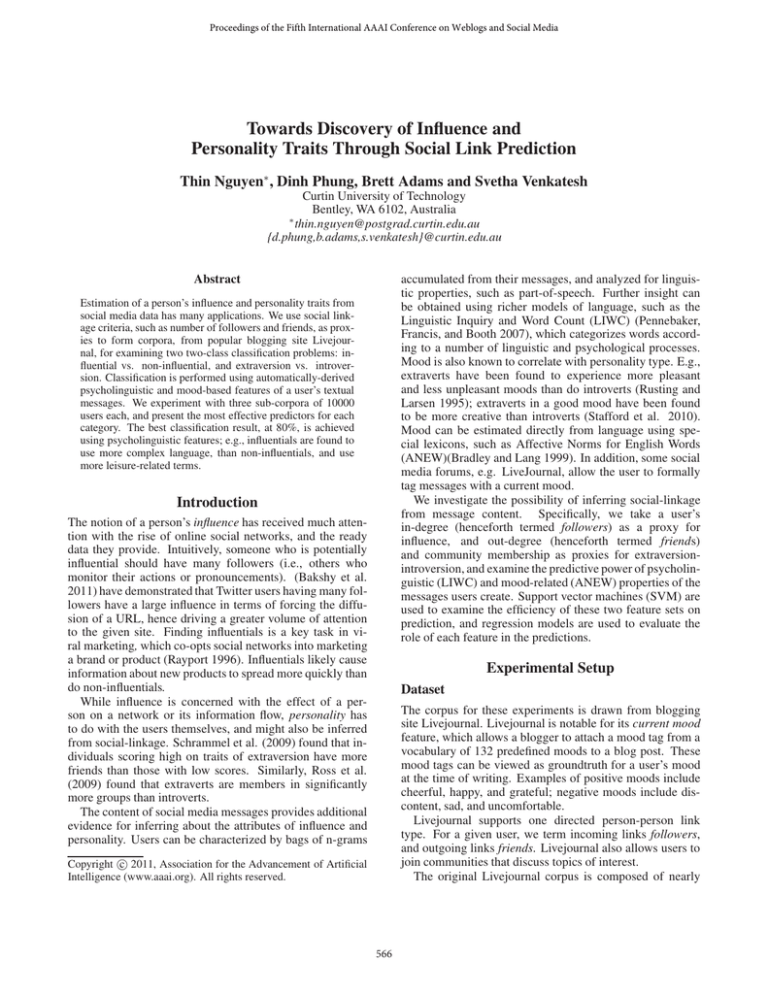
Proceedings of the Fifth International AAAI Conference on Weblogs and Social Media
Towards Discovery of Influence and
Personality Traits Through Social Link Prediction
Thin Nguyen∗ , Dinh Phung, Brett Adams and Svetha Venkatesh
Curtin University of Technology
Bentley, WA 6102, Australia
∗
thin.nguyen@postgrad.curtin.edu.au
{d.phung,b.adams,s.venkatesh}@curtin.edu.au
accumulated from their messages, and analyzed for linguistic properties, such as part-of-speech. Further insight can
be obtained using richer models of language, such as the
Linguistic Inquiry and Word Count (LIWC) (Pennebaker,
Francis, and Booth 2007), which categorizes words according to a number of linguistic and psychological processes.
Mood is also known to correlate with personality type. E.g.,
extraverts have been found to experience more pleasant
and less unpleasant moods than do introverts (Rusting and
Larsen 1995); extraverts in a good mood have been found
to be more creative than introverts (Stafford et al. 2010).
Mood can be estimated directly from language using special lexicons, such as Affective Norms for English Words
(ANEW)(Bradley and Lang 1999). In addition, some social
media forums, e.g. LiveJournal, allow the user to formally
tag messages with a current mood.
We investigate the possibility of inferring social-linkage
from message content. Specifically, we take a user’s
in-degree (henceforth termed followers) as a proxy for
influence, and out-degree (henceforth termed friends)
and community membership as proxies for extraversionintroversion, and examine the predictive power of psycholinguistic (LIWC) and mood-related (ANEW) properties of the
messages users create. Support vector machines (SVM) are
used to examine the efficiency of these two feature sets on
prediction, and regression models are used to evaluate the
role of each feature in the predictions.
Abstract
Estimation of a person’s influence and personality traits from
social media data has many applications. We use social linkage criteria, such as number of followers and friends, as proxies to form corpora, from popular blogging site Livejournal, for examining two two-class classification problems: influential vs. non-influential, and extraversion vs. introversion. Classification is performed using automatically-derived
psycholinguistic and mood-based features of a user’s textual
messages. We experiment with three sub-corpora of 10000
users each, and present the most effective predictors for each
category. The best classification result, at 80%, is achieved
using psycholinguistic features; e.g., influentials are found to
use more complex language, than non-influentials, and use
more leisure-related terms.
Introduction
The notion of a person’s influence has received much attention with the rise of online social networks, and the ready
data they provide. Intuitively, someone who is potentially
influential should have many followers (i.e., others who
monitor their actions or pronouncements). (Bakshy et al.
2011) have demonstrated that Twitter users having many followers have a large influence in terms of forcing the diffusion of a URL, hence driving a greater volume of attention
to the given site. Finding influentials is a key task in viral marketing, which co-opts social networks into marketing
a brand or product (Rayport 1996). Influentials likely cause
information about new products to spread more quickly than
do non-influentials.
While influence is concerned with the effect of a person on a network or its information flow, personality has
to do with the users themselves, and might also be inferred
from social-linkage. Schrammel et al. (2009) found that individuals scoring high on traits of extraversion have more
friends than those with low scores. Similarly, Ross et al.
(2009) found that extraverts are members in significantly
more groups than introverts.
The content of social media messages provides additional
evidence for inferring about the attributes of influence and
personality. Users can be characterized by bags of n-grams
Experimental Setup
Dataset
The corpus for these experiments is drawn from blogging
site Livejournal. Livejournal is notable for its current mood
feature, which allows a blogger to attach a mood tag from a
vocabulary of 132 predefined moods to a blog post. These
mood tags can be viewed as groundtruth for a user’s mood
at the time of writing. Examples of positive moods include
cheerful, happy, and grateful; negative moods include discontent, sad, and uncomfortable.
Livejournal supports one directed person-person link
type. For a given user, we term incoming links followers,
and outgoing links friends. Livejournal also allows users to
join communities that discuss topics of interest.
The original Livejournal corpus is composed of nearly
c 2011, Association for the Advancement of Artificial
Copyright Intelligence (www.aaai.org). All rights reserved.
566
19 million blog posts having current mood tags, made by
over 1.6 million bloggers, during the years 2000 to 2010.
On average, each blogger has 10 followers, 23 friends, and
joins 7 communities. In order to explore the question of
inferring personality traits and influence, we construct subcorpora containing users with extreme numbers of followers
and friends and community membership. The precise criteria for these sub-corpora are discussed below. To avoid spam
and noisy data, the upper bound for link number is 150 (according to Dunbar’s number (Dunbar 1993), a quasi-limit on
the number of meaningful relationships a person can have).
In addition, only users posting not less than 20 posts are
taken into account.
Figure 1: Prediction performance (F-measure).
Influentials and non-influentials corpora A corpus of
influentials was created by collecting users, beginning with
those having 150 followers, and less until a total of 5000
users had been collected. Users in this corpus have been active for less than one year, and have followers ranging from
78 to 150. Similarly, a non-influentials corpus was formed
from 5,000 users, active for more than one year, and having
only one or two followers.
the logit(p) (and thus p). Conversely, if βi is less than zero,
an increase (or decrease) in xi value is associated with a
decrease (or increase) in p. If βi equals zero, xi has no predictive power for predicting personality traits of a user.
Certain LIWC groups consist of others. E.g., affect (affective processes) consists of negemo (negative emotion)
and posemo (positive emotion), resulting in high correlations among these LIWC groups. To reduce effects of multicollinearity in a multiple regression model, those predictor
variables highly correlated are not taken together into the
initial model. For example, since negemo and posemo are
selected, affect is not taken into the initial model.
The subsequent decision to include or remove a predictor in the regression model is based on the Akaike information criterion (AIC), where AIC is defined as the residual
deviance for the model plus twice the number of parameters
in the model. Smaller AIC values indicate better models.
Ten-fold cross-validation is conducted for each SVM
classifier and each logistic regression. The average accuracy
and F-measure of predictions are reported.
Extraversion-introversion corpora based on number of
friends A corpus of extroverts, based on number of
friends, was created with a cut-off of 5,000 users, active for
less than one year, having number of friends in the range
108 to 150. The introverts corpus was created from 5,000
users, active for more than one year, having between 1 and
3 friends.
Extraversion-introversion corpora based on number of
communities Corpora for extroverts and introverts were
created based on the number of communities a user had
joined. Each corpus has 5000 users, with extraverts active
for less than one year, and introverts active more than one
year. The range of number of communities for extroverts is
56 to 150; for introverts, it is one to two communities.
Experimental Results
LIWC categories are found to be better than moods for predicting influentials and extraverts. The average accuracy and
F-measure of the predictions are approximately 80% when
using LIWC and 70% when using moods. We found the
SVM results to be comparable to that of logistic regression,
as shown in Figure 1. We therefore focus on interpreting
parameters estimated from the logistic regression model.
Prediction model
An SVM classifier is used to examine the efficiency of
LIWC categories and moods for predicting influence and
personality type. A logistic regression model (LR) is also
used to examine the predictive effect of each feature once
the parameter is estimated.
Suppose we use LIWC features to predict whether a user
is an extravert or introvert, the logistic model defines
logit(p) = log
Are you influential?
On building a regression model for influentials prediction
using LIWC, after removing correlated features–e.g., affect,
anx, anger, or sad (since posemo and negemo are used)–39
LIWC features, from total of 68 groups1, form the independent variables of the initial model. Then predictors are selected according to the AIC criterion. The resulting model
for prediction of influentials using LIWC is shown in Table
1.
The difference of language use in terms of LIWC features
in the model by influentials and non-influentials can be seen
n
p
βi xi
=α+
1−p
i=1
where p is the probability of the user being an extravert,
x1 , x2 , ..., xn are independent variables, representing LIWC
p
is the
features, α and βs are regression parameters, and 1−p
odds ratio.
The parameters α and βs are estimated through training data using a standard maximum likelihood approach
(Wasserman 2004) and the resulting model is used on testing data. If βi is greater than zero, an increase (or decrease)
in xi value is associated with an increase (or decrease) in
1
The description for these LIWC groups
http://www.liwc.net/descriptiontable1.php
567
shown
at
Features
(Intercept–α)**
sixltr**
leisure**
number*
body**
work**
βi
1.11
30.3
50.8
30.1
51.2
-61.6
Features
dic**
wps**
shehe**
swear**
nonfl**
filler*
Features
βi
-4.97
-0.0289
-23.7
-21.7
-120
-89.7
Table 1: Regression model for prediction of influentials using psycholinguistic (LIWC) features (**: ps < .001, *: ps <
.01).
βi
Features
βi
Features
βi
-5.1
α
0.6
contemplative
-3.3
loved
impressed
20.4
bored
-3.9
aggravated
-7.4
working
8.2
confused
-4.0
discontent
-10.4
curious
13.5
giddy
-7.0
drunk
-8.5
creative
10.4
hyper
-7.4
indifferent
-13.3
rushed
14.0
indescribable
-6.0
rejuvenated
-17.0
busy
8.6
sad
-7.2
drained
-11.6
shocked
11.0
stressed
-5.7
pissed off
-12.4
amused
5.0
anxious
-7.5
lonely
-11.5
okay
5.5
mellow
-9.5
depressed
-14.5
Table 2: Regression model for influentials prediction using
mood tags as features (ps<.001).
(a) Influentials vs. non-influentials characterized by LIWC
categories.
(a) Influentials vs. non-influentials characterized by mood
tags.
(b) Extraverts vs. introverts (based on number of friends) characterized by LIWC categories.
(b) Extraverts vs. introverts (based on number of friends) characterized by mood tags.
(c) Extraverts vs. introverts (based on community membership) characterized by LIWC categories.
(c) Extraverts vs. introverts (based on community membership) characterized by mood tags.
Figure 2: Differences between influentials and noninfluentials, and extraverts and introverts, characterized by
LIWC categories.
Figure 3: Differences between influentials vs. noninfluentials and extraverts vs. introverts on tagging moods.
568
in Figure 2a. Influentials prefer using words in the sixltr category, which is referred to as complex language (Tausczik
and Pennebaker 2010) and a marker of presidential language
(Slatcher et al. 2007). On the contrary, non-influentials
prefer using words in the spoken category, e.g., nonfluency
(nonfl, e.g, er, hm, umm) or fillers (e.g., blah). Also, influentials use more leisure words (e.g., karaoke, chat), more number words (e.g., firstly, billion, twice), fewer swear words
(e.g., damn, piss), and fewer words per sentence (wps) than
do non-influentials.
On building a regression model for influentials using
mood, all 132 moods are used as predictors in the initial regression model. The features are then selected into the final
model according to the AIC criterion. The resulting model
for prediction of influentials using moods is shown in Table
2.
The differences in manifestation of mood usage in the
model by influentials and non-influentials are shown in Figure 3a. Influentials use more high valence moods (all are
larger than 6.0, based on ANEW words, where the valence
scale ranges from 1–9; the larger the valence value, the happier the word) and more positive emotion moods (based on
LIWC, except shocked) than do non-influentials. In contrast,
non-influentials use more low valence moods (all are smaller
than 5.0, except loved), and more negative emotion moods
than do influentials.
that psycholinguistic features have more predictive power
than sentiment for popularity and personality traits.
Estimation of those who are most influential in a social
network is of much use in viral marketing, where marketers
are concerned to place the maximum investment in consumers who may drive the diffusion of positive opinion further than non-influentials. There is a role for personality prediction in the implementation of personalized information
retrieval applications, or user-targeted advertising, where the
most suited advertisement from a set of potential advertisements can be delivered to a particular user.
We have used social linkage as proxy for the complex concepts of influence, and personality traits. Self-report surveys
for personality trait groundtruth, and content-based analysis
of information diffusion to estimate influence, would augment this analysis.
References
Bakshy, E.; Hofman, J. M.; Mason, W. A.; and Watts, D. J. 2011.
Everyone’s an influencer: Quantifying influence on Twitter. In
Proc. of the Intl. Conf. on Web Search and Data Mining (WSDM).
Bradley, M., and Lang, P. 1999. Affective norms for English words
(ANEW): Instruction manual and affective ratings. University of
Florida.
Dunbar, R. I. M. 1993. Coevolution of neocortical size, group
size and language in humans. Behavioral and Brain Sciences
16(4):681–735.
Mairesse, F.; Walker, M.; Mehl, M.; and Moore, R. 2007. Using linguistic cues for the automatic recognition of personality in
conversation and text. Journal of Artificial Intelligence Research
30(1):457–500.
Pennebaker, J.; Francis, M.; and Booth, R. 2007. Linguistic inquiry
and word count (LIWC) [computer software]. Austin, Texas: LIWC
Inc.
Rayport, J. 1996. The virus of marketing. Fast Company
6(1996):68.
Ross, C.; Orr, E.; Sisic, M.; Arseneault, J.; Simmering, M.; and
Orr, R. 2009. Personality and motivations associated with facebook
use. Computers in Human Behavior 25(2):578–586.
Rusting, C. L., and Larsen, R. J. 1995. Moods as sources of stimulation: Relationships between personality and desired mood states.
Personality and Individual Differences 18(3):321 – 329.
Schrammel, J.; Köffel, C.; and Tscheligi, M. 2009. Personality
traits, usage patterns and information disclosure in online communities. In Proceedings of the 2009 British Computer Society Conference on Human-Computer Interaction, 169–174.
Slatcher, R.; Chung, C.; Pennebaker, J.; and Stone, L. 2007. Winning words: Individual differences in linguistic style among us
presidential and vice presidential candidates. Journal of Research
in Personality 41(1):63–75.
Stafford, L.; Ng, W.; Moore, R.; and Bard, K. 2010. Bolder,
happier, smarter: The role of extraversion in positive mood and
cognition. Personality and Individual Differences 48(7):827–832.
Tausczik, Y., and Pennebaker, J. 2010. The psychological meaning
of words: LIWC and computerized text analysis methods. Journal
of Language and Social Psychology 29(1):24.
Wasserman, L. 2004. All of statistics: a concise course in statistical inference. Springer Verlag.
Are you an extravert or introvert?
The process of building regression models for extraverts prediction is similar to that for influentials prediction. The
LIWC features selected into the final regression models for
predicting extraverts, and the differences in the use of the
LIWC features by extraverts and introverts are shown in
Figures 2b–2c. Similar to influentials, extraverts use fewer
words per sentence (wps) than do introverts, in accord with
the finding of (Mairesse et al. 2007). Extraverts also use
more sixltr (complex language), leisure, number, money
(e.g., audit, cash, owe), and percept (perceptual, e.g., heard,
feeling) words than do introverts. In contrast, and similar to
non-influentials, introverts use more swear and nonfl words
in their posts than do extraverts. Introverts also use more
health (e.g., headache, flu) and negations (again, in accord
with (Mairesse et al. 2007)) than do extraverts.
The moods selected into the final regression models for
predicting extraverts, and the differences in mood usage by
extraverts and introverts, are shown in Figures 3b–3c. All
moods used by extraverts are positive and high valence (except cold). In contrast, introverts use language dominated
by negative and low valence emotions. This accords with
the finding in (Rusting and Larsen 1995) that extraverts experience more pleasant and less unpleasant moods than do
introverts.
Conclusion and Future Work
We have investigated the potential for language style and
sentiment information of messages created in a social media
site to predict social linkage, as proxy for influence and the
personality traits of extraversion–introversion. It was found
569

